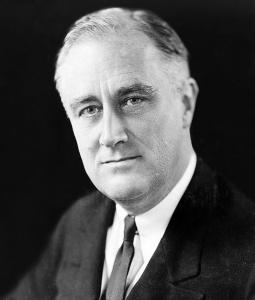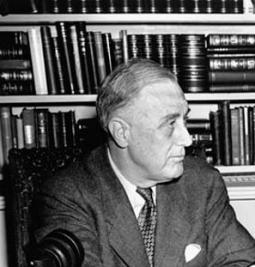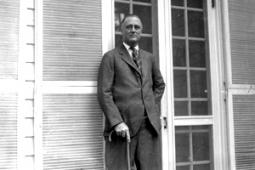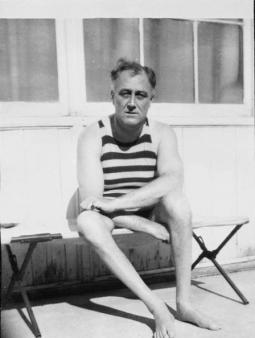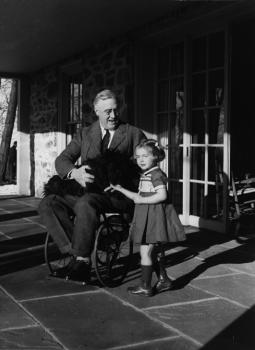Polio Place
A service of Post-Polio Health International
Franklin Delano Roosevelt
Born: January 30, 1882
Died: April 12, 1945
Major Contribution:
Contracting polio before he became the thirty-second president of the United States, Roosevelt founded two highly successful enterprises whose goal was to conquer polio.
Roosevelt regularly visited a spa in Warm Springs, Georgia, starting in 1924, to benefit from the waters. In 1927, he established the Georgia Warm Springs Foundation to fund the facility, which became a mecca for children with polio to receive extensive rehabilitation and to learn to become a part of society once again. Roosevelt and the alumni proved that those with disabilities can lead full and productive lives.
In 1938, he and Basil O'Connor formed the National Foundation for Infantile Paralysis (NFIP)--later to become the March of Dimes (1979). Roosevelt was the driving force behind the not-for-profit, which excelled at keeping polio in the minds of the public and in raising funds. The NFIP funded much of the research that led to the development of the Salk and Sabin vaccines.
Other Information:
Brief Biography: Franklin Delano Roosevelt (FDR) was born in Hyde Park, New York. He was the thirty-second president of the United States and the only person to be elected to four US presidencies. He died three months into his fourth term.
Roosevelt was a central figure in world events during the mid-20th century leading the U.S. through the end of the Great Depression and World War II. His approach to the presidency, exemplified by the New Deal programs, changed American politics because the federal government took on roles that had been previously carried out by the states.
He came from a wealthy family and was educated at home by tutors until attending Groton School (Massachusetts) at age 14. He attended Harvard University and Columbia Law School and was admitted to the New York Bar in 1907. He married Eleanor Roosevelt, his distant cousin, in 1905.
Following the example of his fifth cousin,Theodore Roosevelt, the twenty-sixth President of the United States, FDR entered public service through politics and won election to the New York Senate in 1910. President Wilson appointed him Assistant Secretary of the Navy in 1913, and he was the Democratic nominee for vice president in 1920. Even though the Republican Warren Harding won the election, Roosevelt was considered by many to be an effective campaigner and a potential future president.
In the summer of 1921, at the age of 39, while vacationing with his family at their summer home at Campobello Island in Canada, Roosevelt suddenly became ill and was diagnosed with poliomyelitis, known then as infantile paralysis. He never overcame its paralyzing effects, but with the help of leg braces, and the assistance of Eleanor, his sons and others, he learned to walk by shifting his weight from side to side. He held himself up at podiums and lecterns.
FDR decided to move ahead with his career while hiding his disability from the public with corroboration of his family, close associates and members of the press.
Seventeen years after contracting polio, FDR gave a speech at a joint session of Congress while sitting in his wheelchair, addressing those gathered, he admitted "I hope that you will pardon me for this unusual posture of sitting down during the presentation of what I want to say, but...it makes it a lot easier for me not to have to carry about ten pounds of steel around on the bottom of my legs." This was his only public mention of his disability. He was photographed sitting in his wheelchair in his Hyde Park home, one of the two public photographs of the time showing his disability.
During his twelve years in office, he established the Civilian Conservation Corp (CCC), Tennessee Valley Authority (TVA), Securities and Exchange Commission (SEC), created the Social Security System and repealed prohibition.
FDR died April 12, 1945 of a cerebral hemorrhage at The Little White House on the grounds of the Warm Springs Institute for Rehabilitation in Warm Springs, Georgia.
September 2010/Carol; K. Elliott & Joan L. Headley/Post-Polio Health International
Location of Papers:
Franklin D. Roosevelt Presidential Library and Museum
National Archives
4079 Albany Post Road
Hyde Park, NY 12538
800-FDR-VISIT or 845-486-7770
Description of Papers: The Franklin D. Roosevelt Library is a presidential library administered by the National Archives and Records Administration. The Library houses the personal papers of the President and Mrs. Roosevelt created before, during and after the presidency, as well as the records and papers of other various organizations and individuals associated with Roosevelts. See the publication, Historical Materials in the FDR Library for a complete and printable listing of all historical materials in the Roosevelt Archives, including manuscripts, federal records, microfilm, oral history transcripts, and more.
The American Presidency Project, established in 1999 as a collaboration between John Woolley and Gerhard Peters at the University of California, Santa Barbara, contains numerous public documents categorized by documents (e.g. Executive Orders, Proclamations) and by events (e.g. Inaugural Speeches, State of the Union Messages).
Major Articles: Franklin Delano Roosevelt
For FDR documents and papers, see previous biography page and references to The Franklin D. Roosevelt Library and The American Presidency Project.
